Abstract
Endophytic microbiota are being researched as a vital source of beneficial attributes that are of immense importance for enhancing agroecological crop production. In this study, two endophytic strains: Pseudomonas carnis NWUBe30 and Stenotrophomonas geniculata NWUBe21, were isolated from cowpea tissue, and their plant growth-promoting attributes were assessed. The 16S rRNA gene, as well as the key plant growth-promoting genes that they contain, were subjected to polymerase chain reactions (PCR). Furthermore, their genome was sequenced using the Illumina NovaSeq 6000 systems platform. The results indicated that they possess multiple plant growth-promoting attributes, including the solubilization of phosphates, the production of auxin, siderophore, hydrogen cyanide, exopolysaccharide, ammonia, and 1-aminocyclopropane-1-carboxylic acids. Additionally, the plant growth-promoting genes GCD and ASB were amplified via PCR at their expected base pair value. The genome bioinformatics analysis revealed assembled sizes of 5,901,107 bp for P. carnis NWUBe30, with an average G+C content of 60.2%, and for S. geniculata NWUBe21, 512,0194 bp, with a G+C content of 64.79%. Likewise, genes, such as exopolyphosphatase, ferribacilibactin, betalactone, and lassopeptide, that are responsible for promoting plant growth were identified. This study highlights the biotechnological potential of Stenotrophomonas geniculata strain NWUBe21 and the Pseudomonas carnis strain NWUBe30, which can be harnessed to achieve improvements in sustainable agroecological crop production.
1. Introduction
The quest for achieving sustainable and environmentally balanced improvements in food productivity and food safety and security in a challenging and climatic-changing world of global vulnerabilities is of utmost importance. In light of the crisis around the world—Corona Virus, disruptions to business supply-chain logistics, war and famine outbreaks–the task of enhancing crop productivity through agroecologically balanced, renewable microbial resources that are sustainable, cheaper, and ecofriendly is an attractive research focus theme [1,2,3]. Research into the deployment of biostimulants, biopesticides, and biofertilizers as effective bioinoculating agents to improve crop productivity as an alternative/complement to synthetic agrochemicals (as crop production inputs) to achieve sustainable agroproducts (in the form of enhanced outputs) is on an upward trend [4,5]. Therefore, in order to bioprospect and characterize potent bioinoculants, high throughput and advanced sequencing technologies are being deployed as a necessity for characterizing and elucidating the potential of microbial strains with better prospects as bioinoculating agents. Hence, the genomic analysis of these microbial agents, through complete/whole genomic sequencing technology, is of the utmost importance for characterizing the genomic potential of microbial resources that have shown appreciable prospects as potential bioinoculants that could, in fact, be applied as plant-improving microbial strains and could thus achieve higher crop productivity.
Cowpea Vigna unguiculata L. Walpers is of immense benefit to humankind, biodiversity conservation, soil health, and environmental sustainability. It is also highly beneficial to the animal husbandry/fodder industries across the globe, but most importantly in the tropical climatic region of the globe [6,7,8]. Likewise, endophytic microorganisms have beneficial associations with all living plants through their presence in the innermost tissues of their host plants and, importantly, without harmful consequences [9,10,11]. Due to the positive influence of most endophytic microbes in their host plant interrelationships, there are numerous literature sources on their positive attributes as plant immune boosters, in their biocontrolling activities, in their fight against phytopathogens, and in their contributions to improving plant growth [12,13,14]. Thus, it can be said that research, in recent times, on endophytic microbial resources is on an upward trend. The highly potent and superior biopesticidal, biostimulating, and biofertilizing eco-friendly natural resources that are currently accessible could, in fact, be deployed as complements or alternatives to synthetic agrochemical usage in crop production [15,16]. Hence, following on from standardized genomic protocols and downstream bioinformatics analyses, the elucidation of the genomic features and potentialities of two endophytic bacterial strains from cowpea tissue, with their multifaceted plant-improving attributes, is highlighted in this study.
2. Materials and Methods
- The isolation, morphogenomic authentication, and plant growth-stimulating screening of cowpea endophytic bacterial isolates.
Standardized microbiological protocols were followed in the course of isolating, characterizing, and assessing growth improvement under in vitro conditions. In brief, the two endophytic bacterial strains were isolated from cowpea root tissue; the isolates were then subjected to morphological, biochemical, and molecular, as well as plant growth-improving, protocols.
- Isolation protocol.
Several surface sterilization protocols were deployed in preparing the cowpea root tissues for the isolation of the endophytic bacterial strains. Firstly, the root tissues were rinsed under running tap water to remove any attached debris. Further surface sterilization was carried out by washing the cowpea plant samples with 70% ethanol and then (3%) sodium hypochlorite for three minutes. This was followed again by sterilizing the samples with 70% ethanol and then washing it thoroughly three times with sterilized water to remove epiphytic micro-organisms from it. The efficacy of the surface sterilization was assessed by plating the final rinse water on growth media. The sterilized tissues were crushed with a mortar and pestle and diluted using a phosphate buffer saline; then, it was subsequently plated on varied microbiological growth media. The Petri plates were replicated and incubated [17]. Further purification of the isolated endophytes was achieved through several subculturing processes, with the pure isolates finally being stored for further analysis on storage media incorporating 20% glycerol.
- In vitro PGP screening assay.
The potency of the bacterial endophytic isolates to solubilize phosphate was assessed using [18] protocol. Freshly grown 18 h culture of endophytic bacterial strains in Luria Bertani (LB) broth was used as an aliquot to inoculate the National Botanical Research Institute’s Phosphate (NBRIP) solubilization agar plate containing the insoluble calcium triphosphate at 0.5 g/L. The plates were replicated thrice and incubated for 7 days at 30 °C. The appearance of a transparent halo zone around the culture colony confirmed that the isolates did indeed have the potential to solubilize phosphate. Likewise, the quantitative phosphate solubilizing potency using the (NBRIP) solubilizing liquid medium was assessed by the phosphomolybdate blue method at an optical density of 820 nm.
For assessing the indole acetic acid (IAA)-producing abilities of the two endophytic isolates, the [19] protocol was applied. An overnight culture of the endophytic bacterial isolates was used to inoculate peptone water that contained five (5) mM L-tryptophan, and the liquid media was incubated on a rotary shaker at 150 rpm for 48 h and at 30 °C. Thereafter, the cultures were processed and centrifuged to obtain a supernatant; Salkowski reagent was then added to the supernatant in a ratio of 2:1, and the resultant solution was incubated in the dark for 30 min before the absorbance was measured with the aid of a spectrophotometer at 530 nm. A standard curve of IAA was also plotted using various concentrations of indole acetic acid in order to quantify the amount of IAA produced by the endophytic isolates.
The ability of the endophytic bacterial isolates to produce siderophore was assessed qualitatively on Chrome Azural S (CAS) agar plates [20]. The endophytic isolates were freshly grown in the Luria Bertani (LB) medium to obtain 0.5 concentration at OD600. A diffusible disc was then placed on a freshly prepared CAS-blue agar plate. Thereafter, 10 µL aliquots of each endophytic culture was inoculated onto the plate and incubated for 72 h. The appearance of a yellowish-orange halo around the culture colony indicated a positive potency to produce siderophore. To quantify the siderophore produced by the endophytic bacteria isolates, endophytic culture filtrates that were previously grown in CAS medium were mixed in equal volume with freshly prepared CAS solution and incubated for 5 min before taking the spectrophometric readings at 630 nm.
Also, the assay protocol, as described by ([21], was used to assess the potentials of the endophytic bacterial isolates for promoting ACC deaminase activity. A freshly grown overnight endophytic culture was used as the inoculum by harvesting and centrifuging the broth culture to obtain a culture pellet. Thereafter, saline water that had been previously sterilized was used to wash the pellet thoroughly and was then resuspended in saline water before spot inoculation on three (3) mM ACC, incorporating minimal media Petri plates. A minimal media plate that had been incorporated with ammonium sulfate was used as the positive control, while the minimal media plates without any nitrogenous source served as the negative control. All plates were in triplicate and cultured for 72 h at 30 °C. The growth of the endophytic bacteria on the three (3) mM ACC, incorporating minimal media Petri plates, indicated the potential of the endophytic bacterial isolates to promote ACC deaminase activity.
Furthermore, the endophytic isolates were assessed for their potency in producing ammonia [22]. This involved using a freshly grown overnight culture of endophytic bacteria isolates to inoculate 10 mL sterilized peptone water in test tubes and the incubation of this liquid medium on a rotary incubator for 48 h at 30 °C. The development of yellowish to brownish coloration after the addition of Nessler’s reagent (0.5 mL) was a positive indication of the potential of the isolates to produce ammonia.
In addition, the ability of the endophytic isolates to produce exopolysaccharides was assessed using the methodology proposed by [23]. A 10% sucrose-supplemented Luria Bertani (LB) agar was prepared, and the pH of the medium was adjusted to 7 before sterilization. Also, freshly grown overnight cultures of the endophytic isolates were used to impregnate sterile filter paper and were placed carefully inside the LB medium plates before incubation for 48 h at 30 °C. The potential of the isolates to produce exopolysaccharide was indicated by the formation of a mucoid colony on the filter paper.
The ability of the isolated bacterial endophytes to produce hydrogen cyanide (HCN) was determined by the methods of [24]. The endophytic isolates were streaked on the LB agar medium that was incorporated with glycine (4.4 g/L). Thereafter, the sterilized filter paper was dipped into a solution of picric acid, then carefully placed on the lid of the petri-plates and sealed up with parafilm before incubation for 96 h at 30 °C. The isolates proved positive for hydrogen cyanide production when, after incubation, the filter paper changed color from yellowish to a reddish-brown color.
For the molecular studies, a Quick-DNA Zymoclean bacterial and fungal miniprep extraction kit from (Zymo Research Corporation, Irvine, CA, USA) was used, and the directives from the manufacturer were meticulously followed. The extraction kit is efficient and simple for extracting DNA and contains the bashing beads, lysis tubes, buffer, the genomic lysis buffer, genomic DNA prewash, wash buffer, DNA elution buffer, zymo-spin filters, and collection columns. Prior to DNA extraction, the bacteria isolates were cultured in nutrient broth overnight.
The ribosomal DNA (rDNA), containing the 16S rRNA gene for identifying the bacterial strains, as well as the selected key plant growth-promoting genes, was amplified by using both universal 16S primers 341 forward–AGAGTTTGATCCTGGCTCAG; 907-reverse—AAGGAGGTGATCCAGCCGCA, while the specific primers for GCD were forward—GACCTGTGGGACATGGACGT; reverse–GTCCTTGCCGGTGTAGSTCATC. Additionally, the specific primers for ASB forward–GAGAATGGATTACAGAGGAT, reverse-TTATGAACGAACAGCCACTT [25,26,27] were used to orchestrate a polymerase chain reaction (PCR). The phylogenetic relations to other bacterial strains in the GenBank repository were determined by deploying NCBI blasting and Molecular Evolutionary Genetics Analysis (MEGA7) software [28].
Following these experimental processes, two endophytic bacterial strains, namely Stenotrophomonas geniculata NWUBe21 and Pseudomonas carnis NWUBe30, both displaying highly potent growth-enhancing traits, were selected for further genomic exploration.
- Genomic DNA extraction, whole-genome sequencing, and annotation.
A miniprep DNA extraction kit from ZR (Zymo Research Company, USA) was used to extract the DNA from the two endophytic strains that was grown overnight in the liquid medium. The quality check of the extracted DNA was assessed using gel electrophoresis and Nanodrop spectrophotometry (Thermo Fisher, Waltham, MA, USA). Genomic sequencing was carried out in the USA at the Molecular Research Laboratory (MR DNA) in Shallowater, Texas, using the Novaseq 6000 illumina platform. Library preparation was carried out using the DNA Prep (M) Tagmentation library preparation kit (Illumina) and by following the manufacturer’s step-wise guide. Fifty (50) ng DNA was used in preparing the libraries. The samples simultaneously underwent fragmentation and the addition of adapter sequences. These adapters were utilized during a limited-cycle PCR, in which unique indices were added to the sample. Following the library preparation, the final concentration of the libraries was measured using the Qubit®® dsDNA HS Assay Kit (Life Technologies, Santa Clara, CA, USA), and the average library size was determined using the Agilent 2100 Bioanalyzer (Agilent Technologies, Santa Clara, CA, USA). The initial and final concentration of libraries for Stenotrophomonas geniculata NWUBe21 and Pseudomonas carnis NWUBe30 amounted to (108.0 ng/µL: 318.0 ng/µL) and (30.40 ng/µL: 21.00 ng/µL) respectively. The average library sizes for Stenotrophomonas geniculata NWUBe21 and Pseudomonas carnis NWUBe30 were 704 bp and 735 bp, respectively. The libraries were then pooled in equimolar ratios of 0.6 nM and sequenced in terms of paired ends for 300 cycles using the NovaSeq 6000 system (Illumina). Since postsequencing processing entails the use of different platforms, the bioinformatics parameters deployed were set at the default. The Department of Energy Systems biology knowledgebase (Kbase) was the main platform that was deployed [29]. The trimming of the sequences read, and the reads quality assessment was determined using Trimmomatic v0.36, FastQC v.1.0.1, [30,31]. The genome assembling and annotation were achieved using SPAdes v.3.12.0 and (PGAP) version (v4.7), i.e., the Prokaryotic Genome Annotation Pipeline [32,33]. For genome mining, in order to detect important metabolites and their biosynthetic gene clusters, the antiSMASH version 6.0 [34] was used. Using subsystems Technology (RAST version 2.0) and PATRIC version 3.6.12, rapid annotation was used to determine the functions of the genes [35,36].
3. Results
Identification, characteristics, and the plant growth-stimulating attributes of the endophytic strains.
The result obtained from carrying out the exercise to determine the morphological and molecular characteristics of the isolated endophytic strains indicated that the two isolates were Stenotrophomonas geniculata strain NWUBe21 and Pseudomonas carnis strain NWUBe30. The Gram reaction for S. geniculata NWUBe21 indicated that it is Gram-negative and rod in shape, while P. carnis strain NWUBe30 was found to be Gram-negative and rod in shape. The two endophytic strains possess the ability to use starch, maltose, glucose, fructose, and sucrose. They were also found to be nitrate reducers and were oxidase positive. Moreover, the biochemical profile of the isolates revealed their ability to use citrate as a carbon source and that they are catalase and nitrate positive. Both organisms are also indole and Voges-Proskaeur negative and do not ferment mannose, sorbitol, melibiose, maltose, or lactose. The ribosomal ribonucleic acid (rRNA) 16S gene amplification of S. geniculata strain NWUBe21 and P. carnis strain NWUBe30 yielded the expected 1400 bp amplicon size and also the expected base size for plant growth-improving glucose dehydrogenase (GCD) and petrobactin siderophore. The (Asb) biosynthetic gene was amplified (Figure 1). The phylogeny relatedness of the two endophytic strains S. geniculata NWUBe21 and P. carnis NWUBe30 to other closely related bacterial strains in the Genbank is presented in Figure 2A,B, which show 100% similarity with other similar strains. The beneficial in vitro plant growth-stimulating attributes are likewise represented in (Table 1).
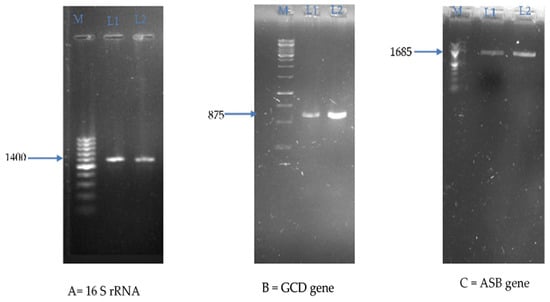
Figure 1.
Endophytic bacterial strains S. geniculata NWUBe21 and P. carnis NWUBe30; amplified genes for 16S rRNA; the glucose dehydrogenase gene (Gcd), and the petrobactin siderophore biosynthetic gene (Asb). M = 1kb ladder; L1 = S. geniculata NWUBe21; L2 = P. carnis NWUBe30.
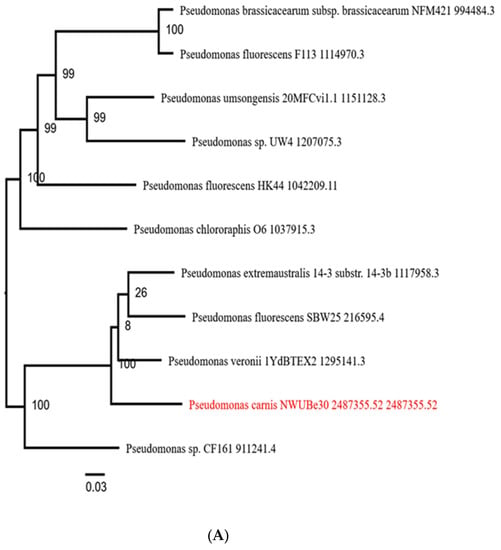
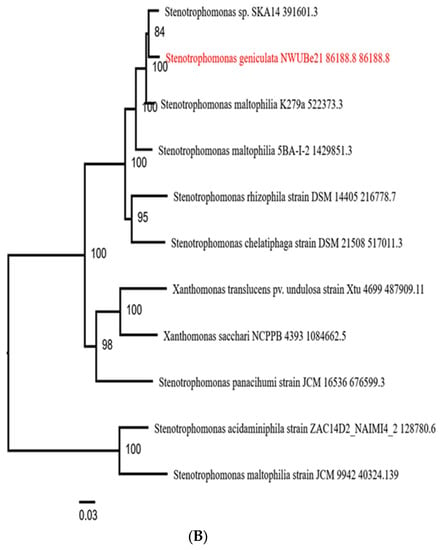
Figure 2.
(A) Phylogenetic relatedness of endophytic Pseudomonas carnis strain NWUBe30 with other isolates in GenBank. (B) Phylogenetic relatedness of endophytic Stenotrophomonas geniculata strain NWUBe21 with other isolates in GenBank.

Table 1.
Growth promoting in vitro and biochemical attributes of the endophytic bacteria P. carnis NWUBe30 and S. geniculata NWU Be21 strains.
3.1. Genomic Features of the Endophytic Pseudomonas carnis Strain NWUBe30 and Stenotrophomonas geniculata Strain NWUBe21
The genome of Pseudomonas carnis strain NWUBe30 was assembled into 23 contigs consisting of 5,901,107 bp and an average G+C content of 60.2%. The total genes that were predicted amounted to 6306, while for the pseudogenes, it was 280 and 87 for the tRNA operons. In addition, the genomic features of Stenotrophomonas geniculata strain NWUBe21 were assembled into 410 contigs and a bp size of 5,120,194, with the G+C percentage content being 64.79. Additionally, the total genes that were predicted amounted to 6234, while for the pseudogenes, it was 169 and 63 tRNA operons. More features of the genome are presented in (Table 2). The RAST annotation categorizes the genes into 427 and 377 subsystems for Stenotrophomonas geniculata strain NWUBe21 and Pseudomonas carnis strain NWUBe30, respectively. An overview of these two genomes is shown in Figure 3A,B and this was created by means of the PATRIC online platform. The circular view shows the contigs and the coding and noncoding features, the antimicrobial resistance genes, the drug targets, and the G+C content of the genome. Different genes for the respective metabolisms, namely carbohydrate, protein, amino acid derivatives, aromatic compounds, iron (and its acquisition secondary metabolisms and several others), stress response, and membrane transport, were present. AntiSMASH predicted the presence of 15 biosynthetic gene clusters in the genomes of Pseudomonas carnis strain NWUBe30 and for Stenotrophomonas geniculata strain NWUBe21 genome; it also predicted six biosynthetic gene clusters that are responsible for secondary metabolite synthesis. The predicted genes included fengycin, lassopeptide, siderophore, viscosin, pyoverdin, arylpolyene, hserlactone, and betalactone (Table 3).

Table 2.
Genomic overview of endophytic strains S. geniculata NWUBe21 and P. carnis NWUBe30.
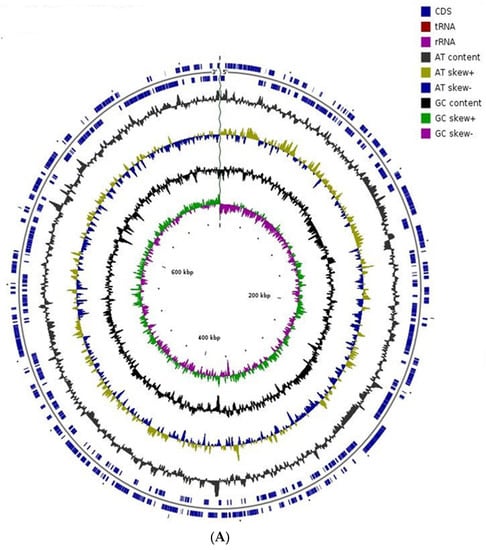
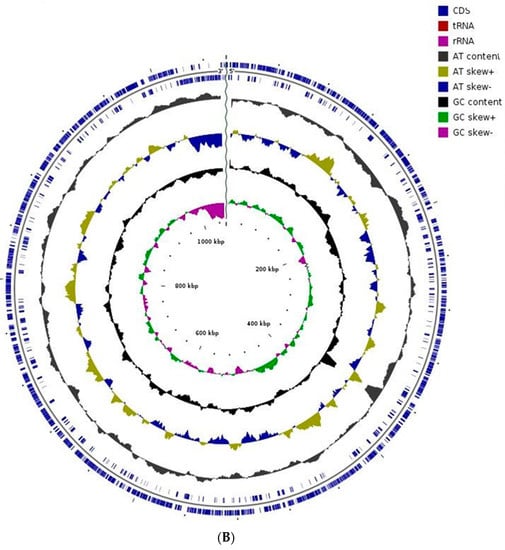
Figure 3.
(A) Circular overview of the genome of endophytic Pseudomonas carnis strain NWUBe30. (B) Circular overview of the genome of endophytic Stenotrophomonas geniculata strain NWUBe21.

Table 3.
Biosynthetic gene clusters of two endophytic bacterial strains, as predicted by antismash.
3.2. Abundance of Plant Growth-Improving Genes in the Genomes of the Endophytic Bacteria Strains
The genomic annotation, genome mining, and PCR exploration of the genetic composition of the two endophytic bacteria confirmed the presence of diverse plant growth-stimulating genes in their genomes. The presence of different genes, as well as the functional/metabolic roles that are responsible for the plant growth stimulation of the endophytic bacteria were predicted using both the Kbase and RAST servers for the genome annotation. Thus, the highlighted results are presented in Table 4 and Figure 4A,B and Figure 5A,B.

Table 4.
Plant growth-stimulating genes in the genome of P. carnis strain NWUBe30 and S. geniculata strain NWUBe21.
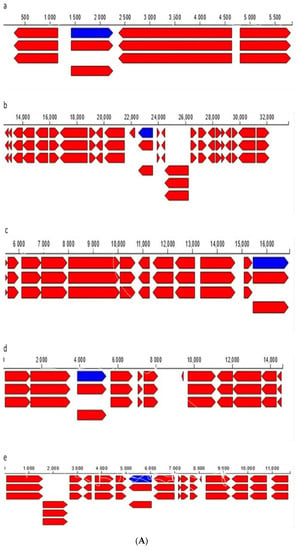
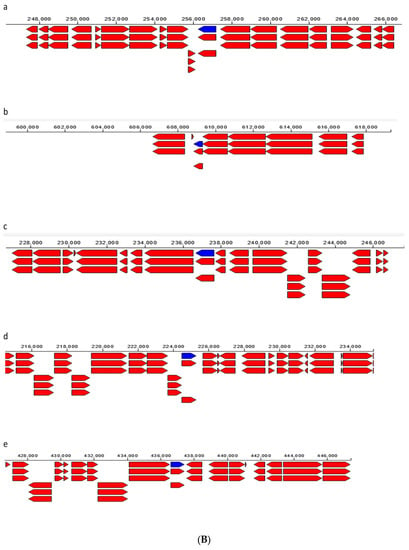
Figure 4.
(A) Annotation of plant probiotic-influencing genes and their location in the genome of endophytic Stenotrophomonas geniculata strain NWUBe21 (a). Acid phosphatase gene (b). Alkaline phosphatase gene (c). Ammonia/Ammonium transporter gene (d). Exopolyphosphatase gene (e). Ferribacilibactin gene. (B) Annotation of plant probiotic-influencing genes and their location in the genome of endophytic Pseudomonas carnis NWUBe30 (a). Auxin efflux carrier protein gene (b). Biofilm PGA auxillary protein gene (c). Iron sideropohore protein gene (d). Nitrogen-fixing nifU gene (e). Pyrroloquinoline quinone (Coenzyme PQQ) biosynthesis protein gene.
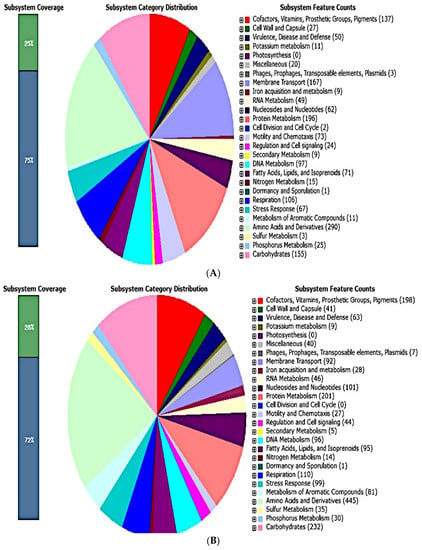
Figure 5.
(A) Endophytic Stenotrophomonas geniculata strain NWUBe21 subsystem overview showing different functional/metabolic roles. (B) Endophytic Pseudomonas carnis strain NWUBe30 subsystem overview showing different functional/metabolic roles.
4. Discussion
- Authentication of the endophytic bacteria strains as plant growth enhancers.
The quest for cheaper, readily available, and natural resource-based alternatives to synthetic agrochemicals as a means of achieving highly intensified improvements in sustainable agricultural productivity is a must in the midst of, among other factors, declining agricultural input resources, climatic change variations, famine, urbanization, war, and the increasing number of people in the world to feed. Endophytic microbiota research is being looked into as a veritable means of achieving the objective of boosting food safety and security in a sustainable manner [37]. In this study, the endophytic bacterial strains Stenotrophomonas geniculata NWUBe21 and Pseudomonas carnis NWUBe30 that were isolated from the tissues of Vigna unguiculata were authenticated as possessing plant growth-improving characteristic features. The results obtained from both of the endophytic strains indicated their potency to solubilize phosphate, produce siderophore, secrete plant hormones, and produce auxin and ammonia, as well as other plant growth-enhancing metabolites. Similar results of endophytic bacterial strains that possess plant growth-stimulating features have been reported [38,39,40].
In order to further examine the genetic basis of the plant growth-promoting traits of Stenotrophomonas geniculata strain NWUBe21 and Pseudomonas carnis strain NWUBe30, the genomic exploration of the two endophytic bacteria was conducted in order to determine the genes responsible for the important secondary metabolites secreted, as well as the genes responsible for the plant growth-stimulating features. The highlights of the beneficial features in the genome of the endophytic bacterial strains that confer plant growth-promoting attributes are summarized below.
- Genetic components that are involved in plant growth enhancement.
The genome exploration of the two endophytic bacterial strains S. geniculata NWUBe21 and P. carnis NWUBe30 indicated the presence of various genes that play vital roles in enhancing plant growth traits.
- Iron acquisition and metabolism.
The genomes of the two endophytic bacterial strains contain genes that are responsible for siderophore production and iron metabolism. These include the iron siderophore receptor protein, the iron siderophore sensor protein, the ferrous iron transport periplasmic protein EfeO, the ferrous iron transport permease EfeU, and the ferrous iron transport peroxidase EfeB. Iron is of vital importance for plant growth and survival. The presence of various iron-acquisition and siderophore genes in the genome of these two bacterial strains is responsible for the development of plants by making iron readily available for utilization by the plants [41,42].
- Motility and Chemotaxis
The movement and attachment of micro-organisms to plants are crucial for effective colonization [43]. Different genes that aid the attachment and movement of these two microbes in plants are present in their genomes. They include the chemotaxis protein CheV, the flagellar L-ring protein FlgH, the flagellar biosynthesis protein FlhA, the predicted signal transduction protein, and the flagellar motor rotation protein MotA.
- Nitrogen Metabolism
Nitrogen remains a key macronutrient that is essential for plant growth; hence, it is regarded as a key nutrient that is generally deployed for agricultural production [44]. Various nitrogen metabolism genes are present in the genome of the two endophytic bacteria, such as NorD—the nitric oxide reductase gene, the ammonium transporter, nitrilase, NorR, and the glutamate ammonia ligase adenylyltransferase gene.
- Phosphorus Metabolism.
Phosphorus is another key mineral that is essential for plant growth and vitality. Phosphate solubilization and the genes that are responsible for the solubilization and metabolism of phosphorus in usable forms are critical to growth in plants, according to Olanrewaju and Babalola, 2019, [45]. The genes that are associated with phosphorus metabolism and that are in the genome of these strains include, among others, the phosphate regulon sensor protein PhoR, the phosphate transport system regulatory protein PhoU, exopolyphosphatase, alkaline phosphatase, the phosphate starvation-inducible protein PhoH, and the polyphosphate kinase protein.
- Plant hormone-auxin biosynthesis.
The presence of the tryptophan synthase alpha chain, the tryptophan synthase beta chain, phosphoribosyl anthranilate isomerase, and anthranilate phosphoribosyl transferase represents the precursors to the plant hormone auxin biosynthesis and are present in the genomes of the two endophytic strains. Auxin plays a key role in the fitness of a plant and in promoting its growth [46].
- Stress Response.
The ability to cope appropriately with different stressors and responses is inherent in the genome of the two endophytic strains. Different stress response genes include aquaporin Z, betaine aldehyde dehydrogenase, the OpgC protein, the glycine betaine transporter OpuD, the ferric uptake regulation protein FUR, the organic hydroperoxide resistance protein, and the organic hydroperoxide resistance protein superoxide dismutase. These stress tolerance genes aid plants in mitigating stressful conditions and ultimately lead to plant growth enhancement [47,48].
Furthermore, there are different biochemical and physiological mechanisms deployed by micro-organisms to achieve positive changes that lead to plant growth enhancement in plant–microbe interrelationships. The data reported in this study indicated that Pseudomonas carnis strain NWUBe30 and Stenotrophomonas geniculata strain NWUBe21 possess plant growth-stimulating attributes that aid in the growth and development of plants. These results are aligned with reports on endophytes as plant growth-improving microbial resources for attaining sustainable agroecological results [49,50,51].
In addition, the exploration into the genomes of the two endophytic isolates, Pseudomonas carnis strain NWUBe30 and Stenotrophomonas geniculata strain NWUBe21, showed the presence of important metabolites and genes that play key/functional roles, amongst other factors, such as chemotaxis, motility, siderophore secretion, iron metabolism, phosphate/phosphorus solubilization/metabolism, nitrogen metabolism, plant hormonal secretions, stress responses, and adaptions. All these highlighted genes confer putative functional attributes on the two endophytic bacterial strains that are crucial to their plant growth-stimulating traits through effective root colonization and the ability to use complex organic and inorganic substrates (thus making them available to plants as usable metabolites), the ability to adapt and cope with stressful conditions in the plant environment, the sequestration of iron and the metabolization of plant use, and phosphate solubilization (the fixing of nitrogen and nitrogen metabolism). The genomic composition of the two endophytic strains confers predictive functional roles on specific genes that regulate plant vigor, fitness, and growth. These results agree with the outcomes of previous studies [14,52,53,54,55,56].
A comparative analysis of the two endophytic bacterial strain genomes indicated that the genome of S. geniculata strain NWUBe21 length was 5,120,194 bp, with a G+C content of 64.79% and 4986 protein coding sequences. Additionally, the P. carnis strain NWUBe30 genome length was 5,901,107 bp, with a G+C content of 60.23% and 5300 protein coding sequences. Therefore, the full genome length of P. carnis strain NWUBe30 was slightly longer than the genome length of S. geniculata strain NWUBe21. However, a G+C content of 64.79% is higher for S. geniculata compared to 60.23% for P. carnis NWUBe30. The number of protein-coding sequences is higher for P. carnis NWUBe30 than for S. geniculata NWUBe21. A comparison of the phytobeneficial attributes of the two endophytic bacterial genomes indicated their molecular differences. P. carnis NWUBe30 had more phosphorus metabolism genes than S. geniculata NWUBe21. Additionally, the iron acquisition and siderophore production genes was more abundant in the genome of P. carnis strain NWUBe30 than S. geniculata NWUBe21. Moreover, the nitrogen metabolism-related genes, such as ammonia transporter, nitrilase enzyme, ammonia assimilation, nitric oxide reductase, amongst others, are more abundant in the genome of P. carnis strain NWUBe30 than in S. geniculata strain NWUBe21. In addition to the predicted functional genes in the genome of the two endophytic bacterial strains, different secondary metabolites that are beneficial to plant growth improvement were observed. The genome of P. carnis strain NWUBe30 possesses 15 different biosynthetic gene clusters that are responsible for the secretion of vital secondary metabolites that are of great significance in plant growth promotion. These metabolites include siderophore, betalactone, hserlactone, pyoverdine, arylpolyene, terpene, fengycin, lankadicin C, fragin, and tolaasin, F among others. The genome of the endophytic bacteria strain S. geniculata NWUBe21 possesses six biosynthetic cluster genes that produce vital secondary metabolites. However, these are less metabolically diverse compared to P. carnis strain NWUBe30.
5. Conclusions
The findings from this research highlighted the plant growth-stimulating features of two endophytic bacterial strains: Stenotrophomonas geniculata NWUBe21 and Pseudomonas carnis NWU Be30. This study further elucidated the genomic insights that are responsible for the beneficial plant growth-stimulating features of their plant host. The exploration of the genomes of these strains indicated multifaceted genes that confer the ability to effectively colonize and enhance plant growth. These findings confirmed the potential of these two endophytic bacterial isolates as candidates for producing bioinoculants for optimizing sustainable agroecological enterprises.
Author Contributions
O.O.B. and O.I.O. conceptualized this project. O.I.O. carried out the wet lab and bioinformatics analyses of the genomes. O.I.O. wrote the first draft of the manuscript, while O.O.B. supervised this study and the editing of the various manuscript drafts. Both authors supported the publication of this manuscript. All authors have read and agreed to the published version of the manuscript.
Funding
OOB appreciates the financial support from the National Research Foundation (NRF) of South Africa (Grant Refs: UID123634; UID132595 OOB).
Data Availability Statement
Pseudomonas carnis strain NWU Be30 and Stenotrophomonas geniculata strain NWU Be21 were deposited in the DDBJ/GenBank database under the whole genome accession number JAMKPY000000000 and JANKJJ000000000, Bioproject number PRJNA793157 and PRJNA790723; the Biosample: SAMN24505123 and SAMN24223644. The Sequence Read Archive raw reads are available at: https://www.ncbi.nih.gov/sra/PRJNA790723 and https://www.ncbi.nih.gov/sra/PRJNA793157, accessed on 20 December 2021 and 28 December 2021.
Acknowledgments
O.I.O. is grateful to North-West University for bursary support and the teaching assistantship granted him. O.O.B. appreciates the financial support from the National Research Foundation (NRF) of South Africa (Grant Refs: UID123634; UID132595 OOB).
Conflicts of Interest
The authors declare no conflict of interest.
References
- Kumawat, K.C.; Razdan, N.; Saharan, K. Rhizospheric microbiome: Bio-based emerging strategies for sustainable agriculture development and future perspectives. Microbiol. Res. 2022, 254, 126901. [Google Scholar] [CrossRef] [PubMed]
- Berendsen, R.L.; Vismans, G.; Yu, K.; Song, Y.; de Jonge, R.; Burgman, W.P.; Burmølle, M.; Herschend, J.; Bakker, P.A.; Pieterse, C.M. Disease-induced assemblage of a plant-beneficial bacterial consortium. ISME J. 2018, 12, 1496–1507. [Google Scholar] [CrossRef] [PubMed]
- Morella, N.M.; Weng, F.C.-H.; Joubert, P.M.; Metcalf, C.J.E.; Lindow, S.; Koskella, B. Successive passaging of a plant-associated microbiome reveals robust habitat and host genotype-dependent selection. Proc. Natl. Acad. Sci. USA 2020, 117, 1148–1159. [Google Scholar] [CrossRef] [PubMed]
- Kumawat, K.C.; Sharma, P.; Nagpal, S.; Gupta, R.; Sirari, A.; Nair, R.M.; Bindumadhava, H.; Singh, S. Dual microbial inoculation, a game changer?—Bacterial biostimulants with multifunctional growth promoting traits to mitigate salinity stress in Spring Mungbean. Front. Microbiol. 2021, 11, 3491. [Google Scholar] [CrossRef]
- Barea, J. Future challenges and perspectives for applying microbial biotechnology in sustainable agriculture based on a better understanding of plant-microbiome interactions. J. Soil Sci. Plant Nutr. 2015, 15, 261–282. [Google Scholar] [CrossRef]
- Omomowo, O.I.; Babalola, O.O. Constraints and prospects of improving cowpea productivity to ensure food, nutritional security and environmental sustainability. Front. Plant Sci. 2021, 12, 751731. [Google Scholar] [CrossRef]
- Ayalew, T.; Samago, T.; Petra, H.; Cadisch, G. Yield response of field-grown cowpea (Vigna unguiculata (L.) Walp.) varieties to Bradyrhizobium inoculation. Agron. J. 2021, 113, 3258–3268. [Google Scholar] [CrossRef]
- Cardona-Ayala, C.; Cardona-Villadiego, C.; Peñate-Pacheco, C.; Araméndiz-Tatis, H.; Espitia-Camacho, M.M. Growth, biomass distribution, gas exchange and chlorophyll fluorescence in cowpea (Vigna unguiculata (L.) Walp.) under drought conditions. Austr. J. Crop Sci. 2020, 14, 371–381. [Google Scholar] [CrossRef]
- Omomowo, O.I.; Babalola, O.O. Bacterial and fungal endophytes: Tiny giants with immense beneficial potential for plant growth and sustainable agricultural productivity. Microorganisms 2019, 7, 481. [Google Scholar] [CrossRef]
- Compant, S.; Cambon, M.C.; Vacher, C.; Mitter, B.; Samad, A.; Sessitsch, A. The plant endosphere world–bacterial life within plants. Environ. Microbiol. 2021, 23, 1812–1829. [Google Scholar] [CrossRef]
- Afzal, I.; Shinwari, Z.K.; Sikandar, S.; Shahzad, S. Plant beneficial endophytic bacteria: Mechanisms, diversity, host range and genetic determinants. Microbiol. Res. 2019, 221, 36–49. [Google Scholar] [CrossRef] [PubMed]
- Adeleke, B.S.; Ayangbenro, A.; Babalola, O.O. Effect of endophytic bacterium, Stenotrophomonas maltophilia JVB5 on sunflowers. Plant Prot. Sci. 2022, 58, 185–198. [Google Scholar] [CrossRef]
- Kaewkla, O.; Sukpanoa, S.; Suriyachadkun, C.; Chamroensaksi, N.; Chumroenphat, T.; Franco, C.M.M. Streptomyces spinosus sp. nov. and Streptomyces shenzhenensis subsp. oryzicola subsp. nov. endophytic actinobacteria isolated from Jasmine rice and their genome mining for potential as antibiotic producers and plant growth promoters. Antonie Van Leeuwenhoek 2022, 115, 871–888. [Google Scholar] [CrossRef] [PubMed]
- Del Carmen Orozco-Mosqueda, M.; Santoyo, G. Plant-microbial endophytes interactions: Scrutinizing their beneficial mechanisms from genomic explorations. Curr. Plant Biol. 2021, 25, 100189. [Google Scholar] [CrossRef]
- Ahmad, T.; Bashir, A.; Farooq, S.; Riyaz-Ul-Hassan, S. Burkholderia gladioli E39CS3, an endophyte of Crocus sativus Linn., induces host resistance against corm-rot caused by Fusarium oxysporum. J. Appl. Microbiol. 2022, 132, 495–508. [Google Scholar] [CrossRef] [PubMed]
- Cui, L.; Yang, C.; Wang, Y.; Ma, T.; Cai, F.; Wei, L.; Jin, M.; Osei, R.; Zhang, J.; Tang, M. Potential of an endophytic bacteria Bacillus amyloliquefaciens 3–5 as biocontrol agent against potato scab. Microb. Pathog. 2022, 163, 105382. [Google Scholar] [CrossRef]
- Kaewkla, O.; Franco, C.M. Rational approaches to improving the isolation of endophytic actinobacteria from Australian native trees. Microb. Ecol. 2013, 65, 384–393. [Google Scholar] [CrossRef]
- Nautiyal, C.S. An efficient microbiological growth medium for screening phosphate solubilizing microorganisms. FEMS Microbiol. Lett. 1999, 170, 265–270. [Google Scholar] [CrossRef]
- Matsuda, R.; Handayani, M.L.; Sasaki, H.; Takechi, K.; Takano, H.; Takio, S. Production of indoleacetic acid by strains of the epiphytic bacteria Neptunomonas spp. isolated from the red alga Pyropia yezoensis and the seagrass Zostera marina. Arch. Microbiol. 2018, 200, 255–265. [Google Scholar] [CrossRef]
- Schwyn, B.; Neilands, J. Universal chemical assay for the detection and determination of siderophores. Anal. Biochem. 1987, 160, 47–56. [Google Scholar] [CrossRef]
- Glick, B.R.; Karaturovíc, D.M.; Newell, P.C. A novel procedure for rapid isolation of plant growth promoting pseudomonads. Can. J. Microbiol. 1995, 41, 533–536. [Google Scholar] [CrossRef]
- Cappucino, J.; Sherman, N. Nitrogen Cycle. Microbiology: A Laboratory Manual; Benjamin/Cumming Pub. Co.: New York, NY, USA, 1992. [Google Scholar]
- Khan, N.; Bano, A. Exopolysaccharide producing rhizobacteria and their impact on growth and drought tolerance of wheat grown under rainfed conditions. PLoS ONE 2019, 14, e0222302. [Google Scholar] [CrossRef] [PubMed]
- Dinesh, R.; Anandaraj, M.; Kumar, A.; Bini, Y.K.; Subila, K.P.; Aravind, R. Isolation, characterization, and evaluation of multi-trait plant growth promoting rhizobacteria for their growth promoting and disease suppressing effects on ginger. Microbiol. Res. 2015, 173, 34–43. [Google Scholar] [CrossRef] [PubMed]
- Chen, W.; Yang, F.; Zhang, L.; Wang, J. Organic acid secretion and phosphate solubilizing efficiency of Pseudomonas sp. PSB12: Effects of phosphorus forms and carbon sources. Geomicrobiol. J. 2016, 33, 870–877. [Google Scholar] [CrossRef]
- Fukuda, K.; Ogawa, M.; Taniguchi, H.; Saito, M. Molecular approaches to studying microbial communities: Targeting the 16S ribosomal RNA gene. J. UOEH 2016, 38, 223–232. [Google Scholar] [CrossRef]
- Raddadi, N.; Cherif, A.; Boudabous, A.; Daffonchio, D. Screening of plant growth promoting traits of Bacillus thuringiensis. Ann. Microbiol. 2008, 58, 47–52. [Google Scholar] [CrossRef]
- Kumar, S.; Stecher, G.; Tamura, K. MEGA7: Molecular evolutionary genetics analysis version 7.0 for bigger datasets. Mol. Biol. Evol. 2016, 33, 1870–1874. [Google Scholar] [CrossRef]
- Cottingham, R. The DOE systems biology knowledgebase (KBase). In Proceedings of the 5th ACM Conference on Bioinformatics, Computational Biology, and Health Informatics, Newport Beach, CA, USA, 20–23 September 2014. [Google Scholar]
- Arkin, A.P.; Stevens, R.L.; Cottingham, R.W.; Maslov, S.; Henry, C.S.; Dehal, P.; Ware, D.; Perez, F.; Harris, N.L.; Canon, S. The DOE systems biology knowledgebase (KBase). bioRxiv 2016, 096354. [Google Scholar] [CrossRef]
- Bolger, A.M.; Lohse, M.; Usadel, B. Trimmomatic: A flexible trimmer for Illumina sequence data. Bioinformatics 2014, 30, 2114–2120. [Google Scholar] [CrossRef]
- Nurk, S.; Bankevich, A.; Antipov, D.; Gurevich, A.A.; Korobeynikov, A.; Lapidus, A.; Prjibelski, A.D.; Pyshkin, A.; Sirotkin, A.; Sirotkin, Y. Assembling single-cell genomes and mini-metagenomes from chimeric MDA products. J. Comput. Biol. 2013, 20, 714–737. [Google Scholar] [CrossRef]
- Aziz, R.K.; Bartels, D.; Best, A.A.; DeJongh, M.; Disz, T.; Edwards, R.A.; Formsma, K.; Gerdes, S.; Glass, E.M.; Kubal, M. The RAST Server: Rapid annotations using subsystems technology. BMC Genom. 2008, 9, 75. [Google Scholar] [CrossRef] [PubMed]
- Blin, K.; Shaw, S.; Kloosterman, A.M.; Charlop-Powers, Z.; Van Wezel, G.P.; Medema, M.H.; Weber, T. antiSMASH 6.0: Improving cluster detection and comparison capabilities. Nucleic Acids Res. 2021, 49, W29–W35. [Google Scholar] [CrossRef] [PubMed]
- Wattam, A.R.; Davis, J.J.; Assaf, R.; Boisvert, S.; Brettin, T.; Bun, C.; Conrad, N.; Dietrich, E.M.; Disz, T.; Gabbard, J.L. Improvements to PATRIC, the all-bacterial bioinformatics database and analysis resource center. Nucleic Acids Res. 2017, 45, D535–D542. [Google Scholar] [CrossRef] [PubMed]
- Overbeek, R.; Olson, R.; Pusch, G.D.; Olsen, G.J.; Davis, J.J.; Disz, T.; Edwards, R.A.; Gerdes, S.; Parrello, B.; Shukla, M. The SEED and the rapid annotation of microbial genomes using subsystems technology (RAST). Nucleic Acids Res. 2014, 42, D206–D214. [Google Scholar] [CrossRef]
- Quintas-Nunes, F.; Rossi, M.J.; Nascimento, F.X. Genomic insights into the plant-associated lifestyle of Kosakonia radicincitans MUSA4, a diazotrophic plant-growth-promoting bacterium. Syst. Appl. Microbiol. 2022, 45, 126303. [Google Scholar] [CrossRef]
- Di, Y.N.; Kui, L.; Singh, P.; Liu, L.F.; Xie, L.Y.; He, L.L.; Li, F.S. Identification and characterization of Bacillus subtilis B9: A diazotrophic plant growth-promoting endophytic bacterium isolated from sugarcane root. J. Plant Growth Regul. 2022, 1–18. [Google Scholar] [CrossRef]
- Tran, T.; French, E.; Iyer-Pascuzzi, A.S. In vitro functional characterization predicts the impact of bacterial root endophytes on plant growth. J. Exp. Bot. 2022. [Google Scholar] [CrossRef]
- Wang, S.; Wang, J.; Zhou, Y.; Huang, Y.; Tang, X. Prospecting the plant growth–promoting activities of endophytic bacteria Cronobacter sp. YSD YN2 isolated from Cyperus esculentus L. var. sativus leaves. Ann. Microbiol. 2022, 72, 1. [Google Scholar] [CrossRef]
- Fadiji, A.E.; Babalola, O.O. Elucidating mechanisms of endophytes used in plant protection and other bioactivities with multifunctional prospects. Front. Bioeng. Biotechnol. 2020, 8, 467. [Google Scholar] [CrossRef]
- Olanrewaju, O.S.; Ayangbenro, A.S.; Glick, B.R.; Babalola, O.O. Plant health: Feedback effect of root exudates-rhizobiome interactions. Appl. Microbiol. Biotechnol. 2019, 103, 1155–1166. [Google Scholar] [CrossRef]
- Xu, Z.; Zhang, H.; Sun, X.; Liu, Y.; Yan, W.; Xun, W.; Shen, Q.; Zhang, R. Bacillus velezensis wall teichoic acids are required for biofilm formation and root colonization. Appl. Environ. Microbiol. 2019, 85, e02116–e02118. [Google Scholar] [CrossRef] [PubMed]
- Alori, E.T.; Babalola, O.O. Microbial inoculants for improve crop quality and human health. Front. Microbiol. 2018, 9, 2213. [Google Scholar] [CrossRef] [PubMed]
- Wan, W.; Qin, Y.; Wu, H.; Zuo, W.; He, H.; Tan, J.; Wang, Y.; He, D. Isolation and characterization of phosphorus solubilizing bacteria with multiple phosphorus sources utilizing capability and their potential for lead immobilization in soil. Front. Microbiol. 2020, 11, 752. [Google Scholar] [CrossRef] [PubMed]
- Shahzad, R.; Waqas, M.; Khan, A.L.; Al-Hosni, K.; Kang, S.-M.; Seo, C.-W.; Lee, I.-J. Indoleacetic acid production and plant growth promoting potential of bacterial endophytes isolated from rice (Oryza sativa L.) seeds. Acta Biol. Hung. 2017, 68, 175–186. [Google Scholar] [CrossRef]
- Woo, O.-G.; Kim, H.; Kim, J.-S.; Keum, H.L.; Lee, K.-C.; Sul, W.J.; Lee, J.-H. Bacillus subtilis strain GOT9 confers enhanced tolerance to drought and salt stresses in Arabidopsis thaliana and Brassica campestris. Plant Physiol. Biochem 2020, 148, 359–367. [Google Scholar] [CrossRef]
- Hantke, I.; Schäfer, H.; Janczikowski, A.; Turgay, K. YocM a small heat shock protein can protect Bacillus subtilis cells during salt stress. Mol. Microbiol 2019, 111, 423–440. [Google Scholar] [CrossRef]
- Ribeiro, V.P.; Gomes, E.A.; de Sousa, S.M.; de Paula Lana, U.G.; Coelho, A.M.; Marriel, I.E.; de Oliveira-Paiva, C.A. Co-inoculation with tropical strains of Azospirillum and Bacillus is more efficient than single inoculation for improving plant growth and nutrient uptake in maize. Arch. Microbiol. 2022, 204, 1–13. [Google Scholar] [CrossRef]
- Adeleke, B.S.; Ayangbenro, A.S.; Babalola, O.O. Genomic analysis of endophytic Bacillus cereus T4S and its plant growth-promoting traits. Plants 2021, 10, 1776. [Google Scholar] [CrossRef]
- Santoyo, G.; Guzmán-Guzmán, P.; Parra-Cota, F.I.; Santos-Villalobos, S.d.l.; Orozco-Mosqueda, M.; Glick, B.R. Plant growth stimulation by microbial consortia. Agronomy 2021, 11, 219. [Google Scholar] [CrossRef]
- Jayakumar, A.; Nair, I.C.; Radhakrishnan, E. Environmental adaptations of an extremely plant beneficial Bacillus subtilis Dcl1 identified through the genomic and metabolomic analysis. Microb. Ecol. 2021, 81, 687–702. [Google Scholar] [CrossRef]
- Mukherjee, A.; Gaurav, A.K.; Patel, A.K.; Singh, S.; Chouhan, G.K.; Lepcha, A.; Pereira, A.P.d.A.; Verma, J.P. Unlocking the potential plant growth-promoting properties of chickpea (Cicer arietinum L.) seed endophytes bio-inoculants for improving soil health and crop production. Land Degrad. Dev. 2021, 32, 4362–4374. [Google Scholar] [CrossRef]
- Olanrewaju, O.S.; Ayilara, M.S.; Ayangbenro, A.S.; Babalola, O.O. Genome mining of three plant growth-promoting Bacillus species from maize rhizosphere. Appl. Biochem. Biotechnol. 2021, 193, 3949–3969. [Google Scholar] [CrossRef] [PubMed]
- Belaouni, H.A.; Compant, S.; Antonielli, L.; Nikolic, B.; Zitouni, A.; Sessitsch, A. In-depth genome analysis of Bacillus sp. BH32, a salt stress-tolerant endophyte obtained from a halophyte in a semiarid region. Appl. Microbiol. Biotechnol. 2022, 106, 3113–3137. [Google Scholar] [CrossRef] [PubMed]
- Kong, W.-L.; Wang, W.-Y.; Zuo, S.-H.; Wu, X.-Q. Genome sequencing of Rahnella victoriana JZ-GX1 provides new insights into molecular and genetic mechanisms of plant growth promotion. Front. Microbiol. 2022, 13, 828990. [Google Scholar] [CrossRef]
Publisher’s Note: MDPI stays neutral with regard to jurisdictional claims in published maps and institutional affiliations. |
© 2022 by the authors. Licensee MDPI, Basel, Switzerland. This article is an open access article distributed under the terms and conditions of the Creative Commons Attribution (CC BY) license (https://creativecommons.org/licenses/by/4.0/).